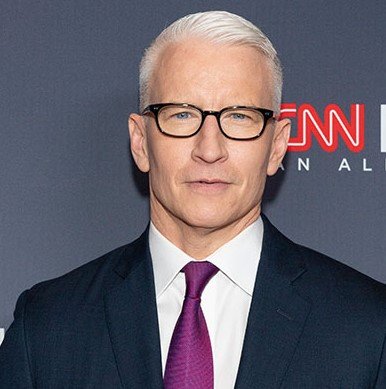Anderson Cooper was on-air from Israel when a live report turned chaotic. Missile alerts blared, and CNN’s most recognizable face had to bolt.
As sirens screamed across Tel Aviv on Sunday night, CNN anchor Anderson Cooper was forced to abandon a live segment and rush for shelter alongside colleagues Clarissa Ward and Jeremy Diamond. The trio, reporting from an outdoor location amid intensifying Israel-Iran hostilities, were interrupted mid-sentence by a 10-minute incoming missile alert. Their phones buzzed. Red lights flashed. And then—dead air.
A Jarring Reminder of Real-Time Risk
The interruption was sudden. Almost too real.
Cooper had just been questioning Ward about Iran’s suspected launch sites when a shrill tone cut through the conversation. He paused. Looked down. Then calmly told viewers, “I should just say that we’re now hearing an alert.”
Ward, seated beside him, glanced off-camera. A producer could be heard faintly saying, “It’s time.”
Ten seconds later, all three reporters disappeared from view.

From Calm Analysis to Urgent Evacuation
There was no panic—but there was tension.
These journalists, seasoned in war zones, knew what the alert meant. In Israel, phones emit a standardized tone when missile attacks are incoming. It’s automated. Cold. Immediate.
Cooper explained to viewers as the camera remained fixed on an empty chair: “These are the alerts that go out… it’s a ten-minute warning of incoming missiles or something incoming from Iran.”
- The verbal alarms, activated by Israel’s Home Front Command, are synced to radar-based detection systems.
- Tel Aviv residents are expected to reach shelters within 90 to 180 seconds of hearing the siren.
- Bomb shelters in media staging areas are now standard protocol, especially for foreign correspondents.
Ward then asked the question everyone at home probably wondered: “Do you want to finish this?”
Cooper didn’t answer directly. He just nodded toward the bunker stairs.
CNN’s Ground Team Adapts Amid Chaos
For CNN, the broadcast interruption was both a logistical hiccup and a stark illustration of their commitment.
The network had just expanded its presence in Israel after U.S. President Donald Trump confirmed targeted attacks on Iranian nuclear infrastructure. The escalation triggered Iranian drone and missile retaliation, making cities like Tel Aviv, Haifa, and Ashkelon high-risk zones.
Jeremy Diamond, who has covered multiple Gaza conflicts, was reportedly the first to grab his equipment and move. Cooper followed. Ward stayed behind for a few seconds, signing off softly: “We’ll be back.”
That’s the thing about covering war. It’s not polished. It’s interrupted. And sometimes, you don’t get to say goodbye properly.
A Live Snapshot of an Escalating Conflict
This wasn’t a one-off event.
It’s part of a growing pattern that’s gripped the region since late May. Here’s a snapshot of the Israel-Iran escalation timeline from publicly available data:
| Date | Event Description | Location |
|---|---|---|
| May 29, 2025 | Israeli strike on IRGC base in Syria | Damascus, Syria |
| Jun 2, 2025 | Iranian drones hit Israeli airbase | Negev, Israel |
| Jun 11, 2025 | U.S. joins Israeli operation with air support | Gulf of Oman |
| Jun 16, 2025 | Hezbollah rockets hit northern Israel | Metula, Israel |
| Jun 22, 2025 | Trump announces strikes on Iranian nuclear facilities | Natanz, Iran |
While the table summarizes key military actions, the human toll—families in shelters, hospitals overwhelmed, reporters ducking into stairwells—tells a deeper story.
Anderson Cooper’s Unscripted Humanity Resonates
The broadcast may have cut off, but Cooper’s steady tone lingered with viewers.
He didn’t dramatize. He didn’t editorialize. He calmly acknowledged the risk and followed protocol.
Social media lit up within minutes:
- “Anderson Cooper literally running for his life on live TV. That’s commitment.”
- “This war is real. It’s not soundbites. It’s sirens and shelters.”
Others, however, criticized CNN for continuing live coverage from an active strike zone, calling it risky and unnecessary. Still, many defended the network, noting their on-the-ground presence brings authenticity that studio commentary can’t replicate.
One user posted, simply: “I trust the guy who brings a flak jacket, not just a microphone.”
Inside CNN’s Security Playbook in War Zones
So how does CNN prepare for something like this?
Cooper’s team had already rehearsed the evacuation protocol. Their field set was less than 40 feet from a secure underground room. The team was required to carry protective gear, including vests, helmets, and radiation-filtered masks, due to fears Iran may escalate with unconventional munitions.
Clarissa Ward, no stranger to warzones, even mentioned during a previous segment how their crew sleeps in shifts and maintains a “go bag” next to their beds.
Only essential personnel remain outdoors during high-alert periods.
It Was Just a Minute—But That Minute Said Everything
That short window—maybe sixty seconds, maybe ninety—before the feed dropped, said more about this conflict than any official statement.
It reminded audiences across the world that war doesn’t care about airtime. That sirens aren’t metaphors. That even people as famous as Anderson Cooper aren’t immune from running for safety in the dark.
And sometimes, the most honest thing a journalist can say is, “We should probably go down.”
